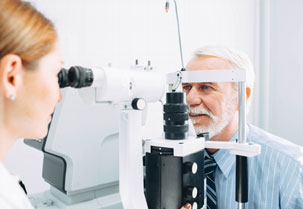
Laser vision correction and cataract |
| 17.02.2022 |
 Cataract – what exactly is it?
Cataract – what exactly is it?Cataract is defined as the clouding of the crystalline lens of the eye. It often develops slowly and painlessly and, if left untreated, can lead to eventual blindness. Usually, the first symptom is impaired vision, and hence the need for ever more frequent replacement of the lenses in glasses.
At some point, the correction does not bring the desired effect anymore, and as the disease continues to develop, visual symptoms may also appear – for instance, double vision or halos around sources of light. They vary depending on the type of cataract we are dealing with.
The most typical type of cataract is an age-related one. Due to the anatomy of the human lens, three main types of cataract can be distinguished – cortical, nuclear sclerotic, and posterior subcapsular. The other types include anterior subcapsular, diabetic, polar, traumatic, congenital, radiation-induced, and secondary cataract.
Patients often develop clouding in more than one area of the lens, which may result in different types of cataract overlapping.
Cataract may constitute a temporary contraindication to a laser vision correction procedure until it is treated surgically. What has to be born in mind though is that there are numerous factors that determine the final decision regarding the qualification for laser correction, including the type of cataract, its stage and potential complications it entails, as well as the patient’s general health condition and the parameters of the cornea (its shape, thickness, and curvature). All of the above factors are checked by an ophthalmic surgeon during the qualifying examination.
Ametropia after a cataract surgery, on the other hand, is an indication for a laser vision correction procedure. This procedure is currently less popular in Poland than in other countries around the world. Following a cataract surgery, you have to wait at least 3 months before you can undergo a laser vision correction procedure.
The qualifying examination, preceding a laser vision correction surgery allows to detect and eliminate potential contraindications to the procedure, including cataract. If you feel that your visual acuity has deteriorated or you have other difficulty seeing clearly, and at the same time you would like to be able to stop wearing glasses or contact lenses permanently, you should check if your vision problems result from a progressing refractive error or from cataract. In order to make an appointment for the qualifying examination, fill in a preliminary qualification form online or use the contact tab.